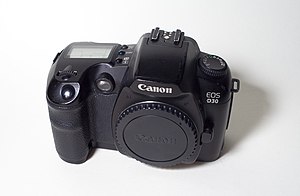Canon EOS D30
 |
|
| Overview | |
|---|---|
| Type | Single-lens reflex |
| Lens | |
| Lens | Interchangeable (EF) |
| Sensor/Medium | |
| Sensor | CMOS |
| Maximum resolution | 2,160 x 1,440 (3.1 megapixels) |
| ASA/ISO range | 100-1600 in 1 EV steps |
| Storage | CompactFlash(CF) (Type I or Type II) and (MD) |
| Focusing | |
| Focus modes | One-shot, AI-Servo, AI-Focus, Manual |
| Focus areas | 3 points (1 + 1) |
| Focus bracketing | none |
| Exposure/Metering | |
| Exposure modes | Full auto, programmed, shutter-priority, aperture priority, manual |
| Exposure metering | TTL, full aperture, zones |
| Metering modes | Evaluative, Center Weighted, Average |
| Flash | |
| Flash | built-in, pop-up |
| Flash bracketing | none |
| Shutter | |
| Shutter | electronic focal plane |
| Shutter speed range | 30 to 1/4000 s |
| Continuous shooting | up to 3.0 frame/s, max 8 frames |
| Viewfinder | |
| Viewfinder | Optical |
| Image Processing | |
| Custom WB | 7 presets, including Auto and custom |
| WB bracketing | none |
| General | |
| Rear LCD monitor | 1.8 in (46 mm), 114,000 pixels |
| Battery | Li-Ion BP-511 rechargeable |
| Optional battery packs | BP-511A, BG-ED3 battery grip |
| Weight | 780 g (body only) |
| Made in | Japan |
The Canon EOS D30 is a discontinued 3.1-megapixel professional digital single lens reflex camera (DSLR) body, initially announced by Canon on May 17, 2000. It is part of the Canon EOS line of cameras and uses the EF lens mount. The EOS D30 was Canon's first "home grown" digital SLR. Before that point Canon had a contract with Kodak to rebrand the Kodak 2-megapixel DCS 520 as Canon EOS D2000 and the 6-megapixel DCS 560 as Canon EOS D6000 digital SLRs, which combined Kodak digital backs and Canon camera bodies.
The D30 was aimed at the enthusiast market, and was intended to occupy the gap between the high-end consumer-market Canon PowerShot Pro70, and Canon's first professional digital SLR, the Canon EOS-1D, which was released in November 2001.
The D30 was succeeded by the 6.3-megapixel D60 in 2002.
...
Wikipedia
